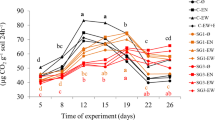Abstract
Various physical and chemical characteristics of earthworm casts collected from a laboratory incubation and a field experiment were examined in relation to their effect on the sorption and the movement of three 14C-labelled ionic herbicides: atrazine, 2,4-dichlorophenoxyacetic acid, and metsulforon methyl. The earthworm casts contained higher levels of fine fractions and total and soluble C. This is attributed to the grinding action of the earthworm gut and selective feeding on zones with higher organic matter and fine size fractions. The earthworm casts had a higher pH than the source soil, resulting in a higher number of surface negative charges. The earthworm casts sorbed higher amounts of herbicides than the source soil, mainly due to the increases in the amount of organic C and fine size fractions. The incrased sorption of herbicides by the casts resulted in decreased leaching.
Similar content being viewed by others
References
Barley KP (1961) The abundance of earthworms in agricultural land and their possible significance in agriculture. Adv Agron 13:249–268
Barriuso E, Baer U, Calvet R (1992) Dissolved organic matter and adsorption-desorption of dimefuron, atrazine, and carbetamide by soils. J Environ Qual 21:359–367
Bolan NS, Syers JK, Tillman RW (1986) Ionic strength effects on the surface charge and adsorption of phosphate and sulphate by soils. J Soil Sci 37:379–388
Douglas JT, Gross MJ, Hill D (1980) Measurement of pore characteristics in a clay soil under ploughing and direct drilling, including use of a radiotracer (144Ce) technique. Soil Tillage Res 1:11–18
Edward CA, Lofty JR (1977) Biology of earthworms, 2nd ed. Chapman and Hall, London
Haimi J, Huhta V (1990) Effects of earthworms on decomposition processes in raw humus forest soil: A microcosm study. Biol Fertil Soils 10:178–183
Joschko M, Diestel H, Larink O (1989) Assessment of earthworm burrowing efficency in compacted soil with a combination of morphological and soil physical measurements. Biol Fertil Soils 8:191–196
Karickhoff SW, Brown OS, Scott TA (1979) Sorption of hydrophobic pollutants on natural sediments and soils. Water Res 13:241–248
Lal R, Akinremi OO (1983) Physical properties of earthworm casts and surface soil as influenced by management. Soil Sci 135:114–122
Lal R, De Vleeschauwer D (1982) Influence of tillage methods and fertilizer application on the chemical properties of worm castings in a tropical soil. Soil Tillage Res 2:37–52
Lavelle P (1988) Earthworm activity and the soil system. Biol Fertil Soils 6:237–251
Lavy TL, Messersmith CG, Knoche HW (1972) Direct liquid scintillation radioassay of 14C labelled herbicides in soil. Weed Sci 20:215–219
Lee KE (1985) Earthworms: Their ecology and relationships with soils and land use. Academic Press, Sydney
Mackay AD, Springett JA, Syers JK, Gregg PEH (1983) Origin of the effect of earthworms on the availability of phosphorus in a phosphate rock. Soil Biol Biochem 15:63–73
Madhun YA, Freed VH, Young JL, Fang SC (1986) Binding of herbicides by water soluble organic material from soil. J Environ Qual 15:64–68
McKenzie BM, Dexter AR (1987) Physical properties of casts of the earthworm Aporrecttodea rosea. Biol Fertil Soils 5:152–157
Mulongoy K. Bedoret A (1989) Properties of worm casts and surface soils under various plant covers in the humid tropics. Soil Biol Biochem 21:197–203
Rao PSC, Davidson JM (1979) Adsorption and movement of selected pesticides at high concentrations in soils. Water Res 13:375–380
Schofield RK (1949) Effect on pH on electric charges carried by clay particles. J Soil Sci 1:1–8
Scullion J, Ramshaw GA (1988) Factors affecting surface casting behaviour in several species of earthworm. Biol Fertil Soils 7:39–45
Springett JA (1983) Effect of five species of earthworm on some soil properties. J Appl Ecol 20:865–872
Stehouwer RC, Dick WA, Traina ST (1993) Characteristics of earthworm burrow lining affecting atrazine sorption. J Environ Qual 22:181–185
Syers JK, Springett JA (1984) Earthworms and soil fertility. Plant and Soil 76:93–104
Tabatabai MA, Bremner JM (1970) Use of the Leco automatic 70 second carbon analyser for total carbon analysis of soils. Soil Sci Soc Am J 34:608–610
Tiwari SC, Tiwari BK, Mishra RR (1989) Microbial population, enzyme activities and nitrogen-phosphorus-potassium enrichment in earthworm casts and in the surrounding soils of a pineapple plantation. Biol Fertil Soil 8:178–182
Author information
Authors and Affiliations
Rights and permissions
About this article
Cite this article
Bolan, N.S., Baskaran, S. Characteristics of earthworm casts affecting herbicide sorption and movement. Biol Fertil Soils 22, 367–372 (1996). https://doi.org/10.1007/BF00334585
Received:
Issue Date:
DOI: https://doi.org/10.1007/BF00334585




